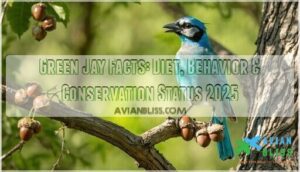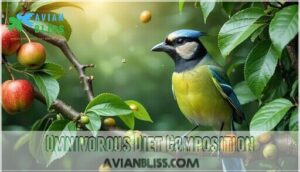This site is supported by our readers. We may earn a commission, at no cost to you, if you purchase through links.

This intelligent corvid calls the oak woodlands of South Texas and Mexico home, where it’s become nature’s ultimate opportunist.
Green jays aren’t picky eaters – they’ll snatch insects, raid bird nests for eggs, feast on acorns, and even catch small reptiles with their sharp beaks.
These social birds stick together in family groups year-round, chattering away with an impressive vocabulary of calls that’d make a parrot jealous.
Their cooperative breeding system and complex social behaviors reveal fascinating secrets about survival.
Table Of Contents
- Key Takeaways
- Green Jay Overview
- Green Jay Diet
- Green Jay Breeding
- Green Jay Behavior
- Green Jay Conservation
- Frequently Asked Questions (FAQs)
- What are Green Jays known for?
- Are Green Jays migratory?
- What are the predators of the Green Jay?
- Is the Green Jay endangered?
- Does the Green Jay migrate?
- What color are Green Jay eggs?
- Can Green Jays be kept as pets in captivity?
- How do Green Jays adapt to changing weather conditions?
- Can Green Jays recognize individual humans and respond?
- How do Green Jays interact with other bird species?
- Conclusion
Key Takeaways
- You’ll instantly recognize green jays by their brilliant emerald backs, electric-blue heads, and striking black-and-white facial patterns that make them one of North America’s most vibrant songbirds.
- You’ll find these intelligent corvids are nature’s ultimate opportunists, eating everything from insects and bird eggs to acorns and small reptiles with their sharp, versatile beaks.
- You’ll discover they’re highly social birds that stick together in family groups year-round, using an impressive vocabulary of calls and cooperative breeding systems to ensure survival.
- You’ll be pleased to know green jays aren’t endangered – they’re classified as "Least Concern" with stable, even increasing populations, though habitat protection in their limited South Texas range remains important.
Green Jay Overview
You’ll discover the Green Jay (Cyanocorax yncas) stands out as one of North America’s most vibrant songbirds, displaying brilliant green, blue, yellow, and black plumage.
This intelligent corvid ranges from southern Texas through Central America to South America, thriving in dense woodlands and scrubland environments.
Scientific Name and Classification
When you’re exploring bird classification, you’ll find the Green Jay carries the scientific name Cyanocorax yncas within taxonomy systems.
This vibrant species belongs to the Corvidae family under the order Passeriformes, making species identification straightforward for ornithologists.
Bird taxonomy places it among intelligent corvids, where scientific nomenclature helps distinguish it from related jays across different regions.
Physical Characteristics and Appearance
The green jay captivates with its stunning appearance that seems painted by nature’s most artistic hand.
Nature’s masterpiece takes flight in a dazzling display of emerald, sapphire, and gold.
This vibrant plumage creates a living rainbow in the wild.
- Plumage Colors: Brilliant green bodies contrast beautifully with blue-and-black heads and bright yellow bellies
- Beak Shape: Stout beak perfectly adapted for cracking seeds and catching insects
- Eye Color: Bright yellow eyes shine like golden jewels against dark facial feathers
- Body Size: Medium songbird measuring 25-29 centimeters with impressive 15-inch wingspans
Habitat and Distribution
You’ll find green jays across a surprisingly limited geographic range, stretching from southern Texas through Mexico to northern Honduras, plus separate populations in South America.
These vibrant birds call forest habitats home, particularly dense woodlands and brushlands near riparian zones.
Unlike many species, green jays show no migration patterns, staying put year-round in their territories despite ongoing habitat loss pressures, which makes their presence in these areas a notable aspect of their year-round behavior.
Green Jay Diet
You’ll discover that Green Jays have remarkably diverse eating habits that set them apart from many other songbirds.
These intelligent corvids consume everything from insects and small vertebrates to fruits and seeds, using clever foraging techniques to maximize their food intake throughout the year.
Omnivorous Diet Composition
You’ll discover Green Jays maintain a remarkably diverse omnivorous diet that adapts to seasonal availability.
These intelligent corvids balance their nutritional needs through strategic Food Sources selection, combining protein-rich animal matter with energy-dense plant materials for maximum Nutritive Value.
- Insect Foraging provides essential proteins during breeding season when growing chicks need maximum nutrition
- Seed Cracking behavior guarantees winter survival when insects become scarce in colder months
- Fruit Consumption delivers vital carbohydrates and fats for energy during migration and molting periods
- Opportunistic feeding allows rapid diet switching when preferred foods disappear from their territory
Their diet and behavior are influenced by their natural habitat range.
Feeding Techniques and Strategies
These vibrant corvids employ diverse Foraging Methods to secure their omnivorous diet.
Their thick bills excel at Seed Cracking techniques, while agile movements enable Aerial Feeding and systematic Ground Foraging.
Bill Probing helps extract insects from bark crevices, showcasing their adaptability.
Understanding bird feeding tips is essential for attracting various bird species, including the Green Jay, to your backyard.
| Technique | Description | Primary Targets |
|---|---|---|
| Bill Probing | Inserting beak into bark crevices | Insects, larvae, spiders |
| Aerial Feeding | Catching prey mid-flight | Flying insects, small arthropods |
| Ground Foraging | Searching terrestrial surfaces | Seeds, fallen fruit, invertebrates |
Food Sources and Variations
You’ll discover the green jay diet varies dramatically based on location and season.
These omnivorous birds adapt their foraging strategies to whatever’s available in their territory. The green jay’s social structure dynamics play a vital role in their foraging behavior.
- Insect foraging peaks during warm months when beetles, grasshoppers, and caterpillars are abundant
- Fruit consumption increases in winter, with birds targeting ebony seeds, acorns, and berries
- Seed cracking behavior involves pounding nuts with their bills to access nutritious contents
Green Jay Breeding
You’ll find Green Jays fascinating during their breeding season, which runs from April through June in their Texas range.
These colorful corvids form strong monogamous pairs that work together to build nests, incubate eggs, and raise their young as devoted partners, showcasing their breeding habits.
Breeding Season and Nesting
During April through June, you’ll witness green jays‘ impressive nest building skills as pairs construct thorny-twig structures lined with moss and grass.
These bird breeding habits involve selecting dense thickets 17-25 feet high for ideal green jay habitat protection.
The breeding season showcases remarkable teamwork as both partners collaborate on nesting duties, preparing sturdy foundations for upcoming egg laying and eventual fledgling care phases.
Green jays often utilize nesting box designs to raise their young safely in a protected environment.
Monogamous Pairs and Parenting
You’ll witness something special when green jays form their lifelong partnerships. These monogamous birds create strong pair bonding that extends far beyond a single breeding season.
Both partners share nesting habits equally, from selecting prime locations to constructing their thorny fortress together. Their parental care demonstrates remarkable teamwork – while one partner incubates, the other stands guard and provides food.
This collaborative approach to bird parenting guarantees their breeding success through shared responsibilities and unwavering dedication to their offspring. The green jays’ nesting success is influenced by factors related to bird nesting strategies, which highlights the importance of monogamous relationships and parental care in their breeding success.
Egg Characteristics and Incubation
Green jay eggs showcase nature’s artistry with their pale gray to greenish white shells, heavily spotted with brown and lavender markings.
You’ll find clutches containing 3-5 eggs during the breeding season.
The female handles incubation duties exclusively for 17-18 days, while her mate feeds her regularly.
Nestlings emerge as helpless chicks, requiring extensive parental care before fledging time arrives three weeks later.
Green Jay Behavior
You’ll discover that Green Jays are highly social birds that form tight family bonds and travel together in noisy flocks.
Their complex behaviors include sophisticated communication skills, clever foraging strategies, and fascinating social interactions that make them one of the most interesting members of the corvid family.
Social Structure and Family Bonds
Family flocks form the backbone of green jay society, where cooperative breeders work together year-round.
These monogamous pairs maintain strong pair bonding while raising young as family groups.
Social learning occurs naturally as juveniles observe adult behaviors.
Through family dynamics and flock behavior, they’ve mastered cooperative breeding strategies that guarantee survival across generations, ensuring the continuation of their family groups.
Vocalizations and Communication
Like a chatty neighbor, Green Jays fill the woods with a variety of bird vocalizations.
Their call patterns range from sharp alarm calls to soft contact notes, making their communication styles complex.
Jays use vocal learning to mimic other bird sounds, even hawks, as a clever trick.
Their song structure and vocalization patterns help keep family groups connected and safe.
Foraging and Feeding Habits
You’ll observe these birds using multiple foraging techniques throughout the day.
Their omnivorous diet drives diverse feeding behavior patterns.
They excel at aerial feeding, snatching insects mid-flight with precision.
Ground foraging reveals their adaptability as they search for seeds and small creatures.
Seed cracking demonstrates their strength, pounding tough shells against branches.
Food caching behavior guarantees survival during scarce periods, storing acorns strategically for later consumption.
Understanding their bird behavior patterns is vital for effective conservation efforts.
Green Jay Conservation
You’ll find that Green Jays maintain a stable population with their current "Least Concern" status on the IUCN Red List.
However, their limited U.S. range in South Texas makes local habitat protection essential for maintaining healthy populations in this region.
Current Conservation Status
You’ll find encouraging news when examining Green Jay conservation status.
The IUCN Red List classifies this species as "Least Concern," reflecting stable Population Trends across their range.
Current bird conservation data shows their numbers are actually increasing, thanks to forest clearing creating new suitable habitats for these adaptable corvids.
- IUCN Red List Status: Classified as "Least Concern" with no immediate Species Protection concerns
- Population Growth: Numbers increasing due to habitat modifications creating favorable conditions
- Conservation Efforts: Minimal intervention required currently, though monitoring continues through wildlife conservation programs
Threats and Vulnerabilities
Green Jays face mounting pressures that threaten their vibrant existence.
Habitat Loss fragments their woodland territories, while Climate Change shifts food availability timing.
Pollution Effects from pesticides weaken immune systems, and Human Threats include illegal trapping.
Fragmentation Impact increases predator access to nests.
Despite their IUCN Red List status as Least Concern, these cumulative stressors disrupt ecosystem balance and challenge their conservation status.
Conservation efforts rely on understanding habitat restoration techniques to protect endangered species, focusing on habitat restoration and addressing Human Threats.
Habitat Preservation and Protection Efforts
Fortunately, you can support Wildlife Conservation through several proven strategies.
National wildlife refuges like Santa Ana protect core Green Jay territory through Forest Preservation initiatives.
Habitat Restoration projects replant native Tamaulipan brushland, while Ecosystem Management programs engage private landowners.
Biodiversity Protection efforts include bird conservation research and wildlife preservation monitoring.
These habitat preservation approaches guarantee bird habitat protection remains effective across Texas.
Effective conservation relies on wildlife conservation efforts that prioritize ecosystem balance.
Frequently Asked Questions (FAQs)
What are Green Jays known for?
If birds threw parties, these would be the loudest guests.
You’ll spot them flaunting their electric green and blue feathers, chattering nonstop, mimicking hawks, and foraging in family flocks—making every day in their territory an adventure.
Are Green Jays migratory?
You won’t find these vibrant corvids packing their bags for seasonal moves. Green jays stick to their year-round territories in Texas, Mexico, and Central America, staying put rather than migrating.
What are the predators of the Green Jay?
Hawks, owls, and snakes routinely threaten you’ll spot these colorful corvids defending themselves.
Raptors like Cooper’s hawks, sharp-shinned hawks, and screech owls pose the greatest danger to Green Jays, while rat snakes target nests containing eggs and chicks.
Is the Green Jay endangered?
No, you don’t need to worry about this colorful bird’s future.
The Green Jay holds "Least Concern" status on the IUCN Red List, meaning populations remain stable and healthy across their range.
Does the Green Jay migrate?
Unlike their wandering cousins, you won’t find Green Jays packing their bags for seasonal journeys.
These vibrant birds stay put year-round, remaining loyal to their Texas and Central American territories without migrating, which makes them a unique species in terms of migration patterns.
What color are Green Jay eggs?
You’ll find Green Jay eggs are pale gray to greenish white with heavy brown and lavender spotting. They’re quite distinctive with their mottled pattern across the shell surface.
Can Green Jays be kept as pets in captivity?
Imagine trying to bottle a rainbow—Green Jays are wild spirits, not suited for cages.
You can’t legally keep them as pets; they thrive in flocks and forests, needing freedom, social bonds, and space to roam.
How do Green Jays adapt to changing weather conditions?
You’ll notice these adaptable birds shift their foraging patterns with weather changes.
They seek shelter in dense vegetation during storms and adjust their diet based on seasonal food availability throughout their range, which can be considered a complete adaptation to their environment.
Can Green Jays recognize individual humans and respond?
Looking for whether these intelligent corvids can spot you personally? You’re in luck!
Green Jays possess remarkable recognition abilities and can distinguish individual humans, often responding differently to familiar versus unfamiliar people based on past interactions.
How do Green Jays interact with other bird species?
About 80% of Green Jay flocks interact with other species while foraging.
You’ll see them boldly chase off rivals, mimic hawk calls to scare competitors, and sometimes join mixed flocks—always keeping things lively in the treetops with their lively behavior.
Conclusion
Did you know a green jay’s family group can include up to eight birds working together?
When you spot a green jay, you’re seeing a bird that thrives on teamwork, adaptability, and clever foraging.
Their unique diet, social skills, and striking colors make them stand out in the wild.
By learning about the green jay, you’re helping raise awareness for their conservation. Keep your eyes open—you never know when you’ll spot these feathered wonders in action!











